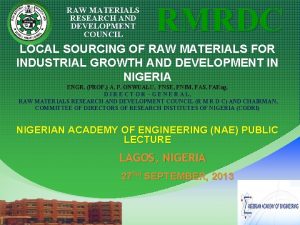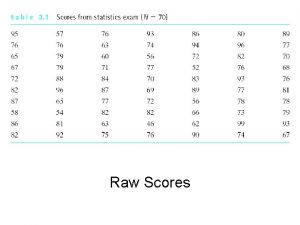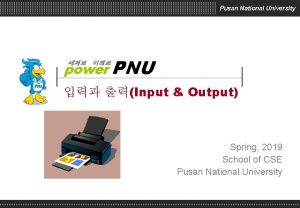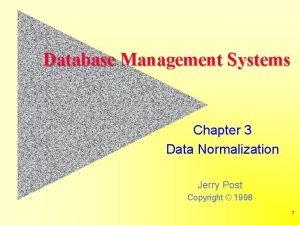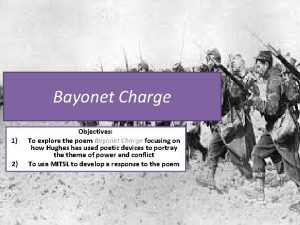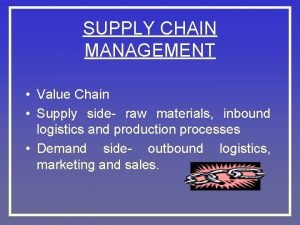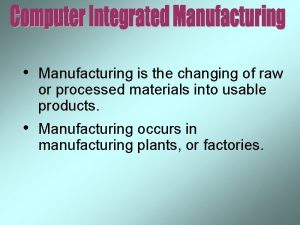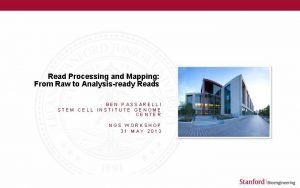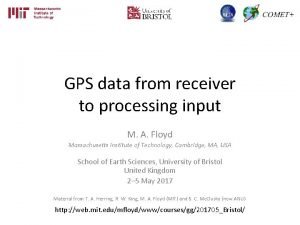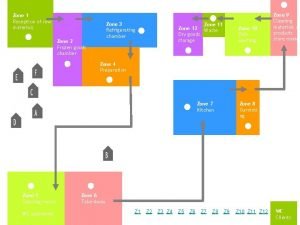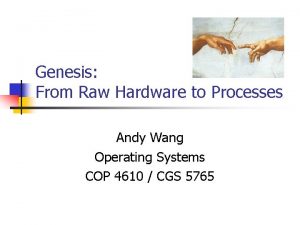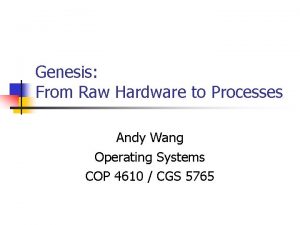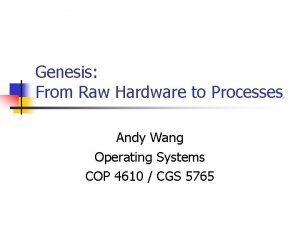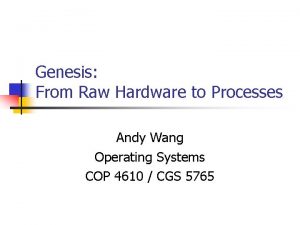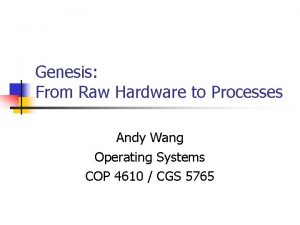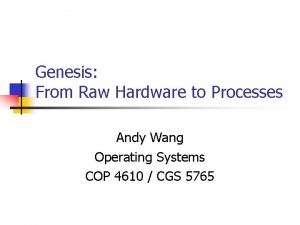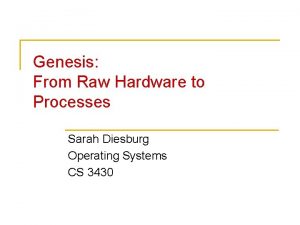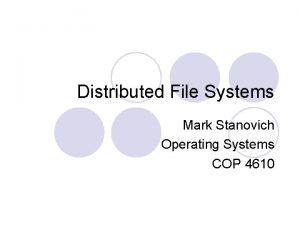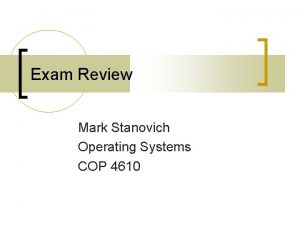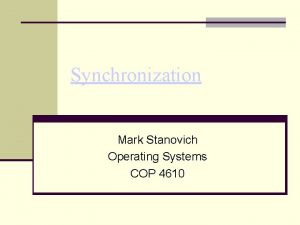Genesis From Raw Hardware to Processes Mark Stanovich





























- Slides: 29

Genesis: From Raw Hardware to Processes Mark Stanovich Operating Systems COP 4610

How is the first process created? What happens when you turn on a computer? How to get from raw hardware to the first running process, or process 1 under UNIX? Well…it’s a long story… It starts with a simple computing machine Florida State University 2

Long, Long Ago…(during the 1940 s) John von Neumann invented von Neumann computer architecture A CPU A memory unit I/O devices (e. g. , disks and tapes) Florida State University 3

In von Neumann Architecture Programs are stored on storage devices Programs are copied into memory for execution CPU reads each instruction in the program and executes accordingly Florida State University 4

A Simple CPU Model Fetch-execute algorithm During a boot sequence, the program counter (PC) is loaded with the address of the first instruction The instruction register (IR) is loaded with the instruction from the address Florida State University 5

Fetch-Execute Algorithm while (not halt) { // increment PC PC IR … 3000 load r 3, b 3000 load r 4, c 3004 … Memory addresses Florida State University 7

Fetch-Execute Algorithm while (not halt) { // increment PC PC … 3004 // execute(IR) IR load r 3, b 3000 load r 4, c 3004 … Memory addresses Florida State University 8

Fetch-Execute Algorithm while (not halt) { // increment PC PC … 3004 // execute(IR) IR load r 4, c } load r 3, b 3000 load r 4, c 3004 … // IR = memory // content of PC Memory addresses Florida State University 9

Booting Sequence The address of the first instruction is fixed It is stored in read-only-memory (ROM) Why ROM instead of RAM? Florida State University 10

Booting Procedure for i 386 Machines On i 386 machines, ROM stores a Basic Input/Output System (BIOS) BIOS contains information on how to access storage devices Florida State University 11

BIOS Code Performs Power-On Self Test (POST) Checks memory and devices for their presence and correct operations During this time, you will hear memory counting, which consists of noises from the floppy and hard drive, followed by a final beep Florida State University 12

After the POST The master boot record (MBR) is loaded from the boot device (configured in BIOS) The MBR is stored at the first logical sector of the boot device (e. g. , a hard drive) that Fits into a single 512 -byte disk sector (boot sector) Describes the physical layout of the disk (e. g. , number of tracks) Contains code Florida State University 13

After Getting the Info on the Boot Device BIOS loads the code from the MBR and executes it MBR code typically loads a more sophisticated boot loader Florida State University 14

Operating System Loaders GRUB (GRand Unified Bootloader) Florida State University 15

More on OS Loaders Is partly stored in MBR with the disk partition table A user can specify which disk partition and OS image to boot Windows loader assumes only one bootable disk partition After loading the kernel image, OS loader sets the kernel mode and jumps to the entry point of an operating system Florida State University 16

Kernel Mode? Two hardware modes: kernel mode and user mode Implemented as a single bit Some privileged instructions can only be run in kernel mode to protect OS from errant users Operating system generally runs in kernel mode Florida State University 17

Booting Sequence in Brief A CPU jumps to a fixed address in ROM, Loads the BIOS, Performs POST, Loads MBR from the boot device, Loads an OS loader, Loads the kernel image, Sets the kernel mode, and Jumps to the OS entry point. Florida State University 18

Linux Initialization Set up a number of things: Trap table Interrupt handlers Scheduler Clock Kernel modules … Process manager Florida State University 19

Process 1 Is instantiated from the init program Is the ancestor of all processes Controls transitions between runlevels Executes startup and shutdown scripts for each runlevel Florida State University 20

Process Creation Via the fork system call family Florida State University 21

System Calls System calls allow processes running at the user mode to access kernel functions that run under the kernel mode Prevent processes from doing bad things, such as Halting the entire operating system Modifying the MBR Florida State University 22

UNIX System Calls Implemented through the trap instruction trap set kernel mode user level kernel level branch table Florida State University trusted code 23

A fork Example, Nag. c #include <stdio. h> #include <unistd. h> #include <sys/types. h> int main() { pid_t pid; if ((pid = fork()) == 0) { while (1) { printf(“child’s return value %d: I want to play…n”, pid); } } else { while (1) { printf(“parent’s return value %d: After the project…n”, pid); } } return 0; } Parent process Florida State University 24

A fork Example, Nag. c #include <stdio. h> #include <unistd. h> #include <sys/types. h> int main() { pid_t pid; if ((pid = fork()) == 0) { while (1) { printf(“child’s return value %d: I want to play…n”, pid); } } else { while (1) { printf(“parent’s return value %d: After the project…n”, pid); } } return 0; } Parent process Florida State University 25

A fork Example, Nag. c #include <stdio. h> #include <unistd. h> #include <sys/types. h> int main() { #include <stdio. h> pid_t pid; #include <unistd. h> if ((pid = fork()) == 0) { #include <sys/types. h> while (1) { printf(“child’s return value %d: I want tomain() play…n”, pid); int { } pid_t pid; } else { if ((pid = fork()) == 0) { while (1) { printf(“parent’s return value %d: After the project…n”, pid); printf(“child’s return value %d: I want to p } } else { return 0; while (1) { } printf(“parent’s return value %d: After the } Parent process } return 0; } Florida State University Child process 26

A fork Example, Nag. c #include <stdio. h> #include <unistd. h> #include <sys/types. h> int main() { #include <stdio. h> pid_t pid; #include <unistd. h> if ((pid = 3128) == 0) { #include <sys/types. h> while (1) { printf(“child’s return value %d: I want tomain() play…n”, pid); int { } pid_t pid; } else { if ((pid = 0) == 0) { while (1) { printf(“parent’s return value %d: After the project…n”, pid); printf(“child’s return value %d: I want to p } } else { return 0; while (1) { } printf(“parent’s return value %d: After the } Parent process } return 0; } Florida State University Child process 27

A fork Example, Nag. c #include <stdio. h> #include <unistd. h> #include <sys/types. h> int main() { #include <stdio. h> pid_t pid; #include <unistd. h> if ((pid = 3128) == 0) { #include <sys/types. h> while (1) { printf(“child’s return value %d: I want tomain() play…n”, pid); int { } pid_t pid; } else { if ((pid = 0) == 0) { while (1) { printf(“parent’s return value %d: After the project…n”, pid); printf(“child’s return value %d: I want to p } } else { return 0; while (1) { } printf(“parent’s return value %d: After the } Parent process } return 0; } Florida State University Child process 28

Nag. c Outputs >a. out child’s return value 0: I want to …// context switch parent’s return value 3218: After …// context switch child’s return value 0: I want to ^C > play… the project… play… Florida State University 29

Thread Creation Use pthread_create() instead of fork() A newly created thread will share the address space of the current process and all resources (e. g. , open files) + Efficient sharing of states - Potential corruptions by a misbehaving thread Florida State University 30
 What is bayonet charge about poem
What is bayonet charge about poem Concurrent in os
Concurrent in os Internal hardware
Internal hardware Pispk jawa tengah
Pispk jawa tengah Raw socket quotes
Raw socket quotes Pengolahan dan penyajian data
Pengolahan dan penyajian data Graniteville 78 system
Graniteville 78 system On the basis of raw material
On the basis of raw material Kic eit raw materials
Kic eit raw materials Socket raw
Socket raw Raw materials research and development council
Raw materials research and development council Ungrouped frequency table
Ungrouped frequency table What is raw facts
What is raw facts Raw materials of sulphuric acid
Raw materials of sulphuric acid Elisa kraft
Elisa kraft Critical raw materials
Critical raw materials Halimbawa ng soberanya sa pilipinas
Halimbawa ng soberanya sa pilipinas Raw input 뜻
Raw input 뜻 Dog.raw?purchase_id= site:com
Dog.raw?purchase_id= site:com A business that gathers raw goods
A business that gathers raw goods Raw seamed hot khaki
Raw seamed hot khaki Value chain structure
Value chain structure It is the changing of raw
It is the changing of raw Two raw materials necessary for photosynthesis
Two raw materials necessary for photosynthesis Cosphatec
Cosphatec Raw sprouts
Raw sprouts Spotted cashews
Spotted cashews Raw reads meaning
Raw reads meaning Crx to rinex
Crx to rinex Recycle package
Recycle package










